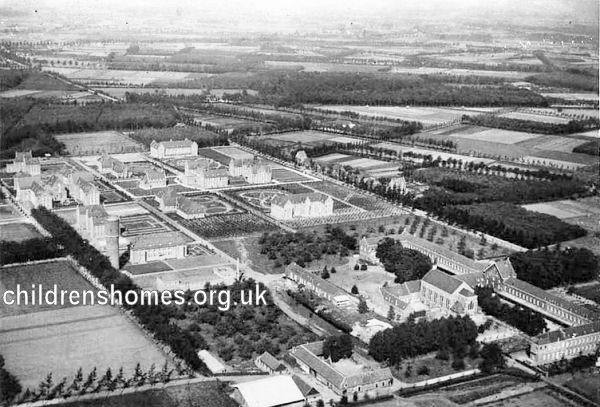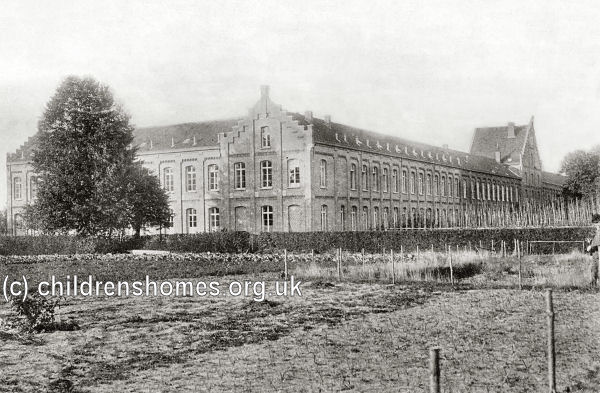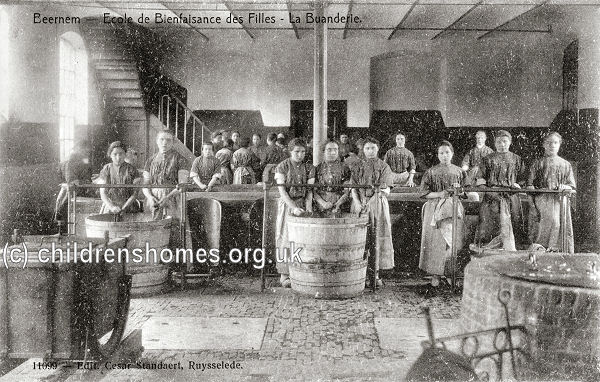Girls' Reform School, Beernem, West Flanders, Belgium
In 1853, a Reform School (École; de Reforme) was established as a companion institution to the boys' school at Ruysselede, and was for the reception of girls and of children of both sexes between the ages of 2 and 7. The school, supervised by the Soeurs de Notre dame, occupied a sixty hectare site located at a site on Reigerlostraat, in the commune of Beernem, West Flanders, about three kilometres from the boys' school.
The new buildings were designed by the same architect as at Ruysselede, M. Dumont. The main block, facing the road, was 94 metres long, with a side-wing at each end running 32 metres to the rear. The space enclosed by these three ranges opened onto the countryside and, planted with trees and lined with benches, served as a playground for inmates. After passing through the entrance door, there were successively placed, on the ground floor, the administration room with ante-chamber, the parlour, the office, the Sisters' refectory and kitchen, the girls' kitchen and stores, the infirmary, the clothing store, and three workshops. The various sections were connected by a covered gallery running the whole length of the building on the courtyard side. The side wing near the front door and the kitchen contained a large refectory, the rear of which was used as the chapel. The other wing contained two classrooms and a workroom for younger students. Beside and at the end of each wing, facing towards the courtyard, was a wash-house and toilets. The attic floor was occupied by the dormitory that covered the entire ground floor. It was furnished with 282 comfortable and elegant hammocks, each having at its foot a small bench, and at its side a box in which to place clothing. At the corners of the dormitory were the supervisors' 'cells' who had a view of all the rows of beds, lavatories, and wash-basins, which were supplied by a pump. The private accommodation of the sisters occupied both floors of the entrance building. Separate from the main building were a shed containing the laundry room, and a small farm with outbuildings, a sheepfold, a greenhouse, etc. A spacious vegetable garden was cultivated by the inmates under the direction of a gardener, and an orchard planted with fruit trees surrounded. A chapel and permanent laundry room were subsequently added.

Girls' Reform School, Beernem, West Flanders, from the north-west, date unknown.

Girls' Reform School, Beernem, West Flanders, main building from the south, early 1900s. © Peter Higginbotham

Wash-house at Girls' Reform School, Beernem, West Flanders, laundry room, early 1900s. © Peter Higginbotham

Sewing-room at Girls' Reform School, Beernem, West Flanders, sewing room, early 1900s.

Older Inmates at Girls' Reform School, Beernem, West Flanders, older girls, c.1909. © Peter Higginbotham
Many of the old school buildings still exist.
Records
Note: many repositories impose a closure period of up to 100 years for records identifying individuals. Before travelling a long distance, always check that the records you want to consult will be available.
- None identfied at present — any information welcome.
Bibliography
- Ducpétiaux, Edouard Exposé de la situation des écoles de reéforme de Ruysselede, de Wynghene et de Beernem: 1849-1858 (Bruxelles, 1861)
- Morier, Alois Un Siècle de l'Établissement d'l'Éducation de l'État a Ruielede (1949, Office de la Protection de 'Enfance)
Links
- None identified at present.
Except where indicated, this page () © Peter Higginbotham. Contents may not be reproduced without permission.


